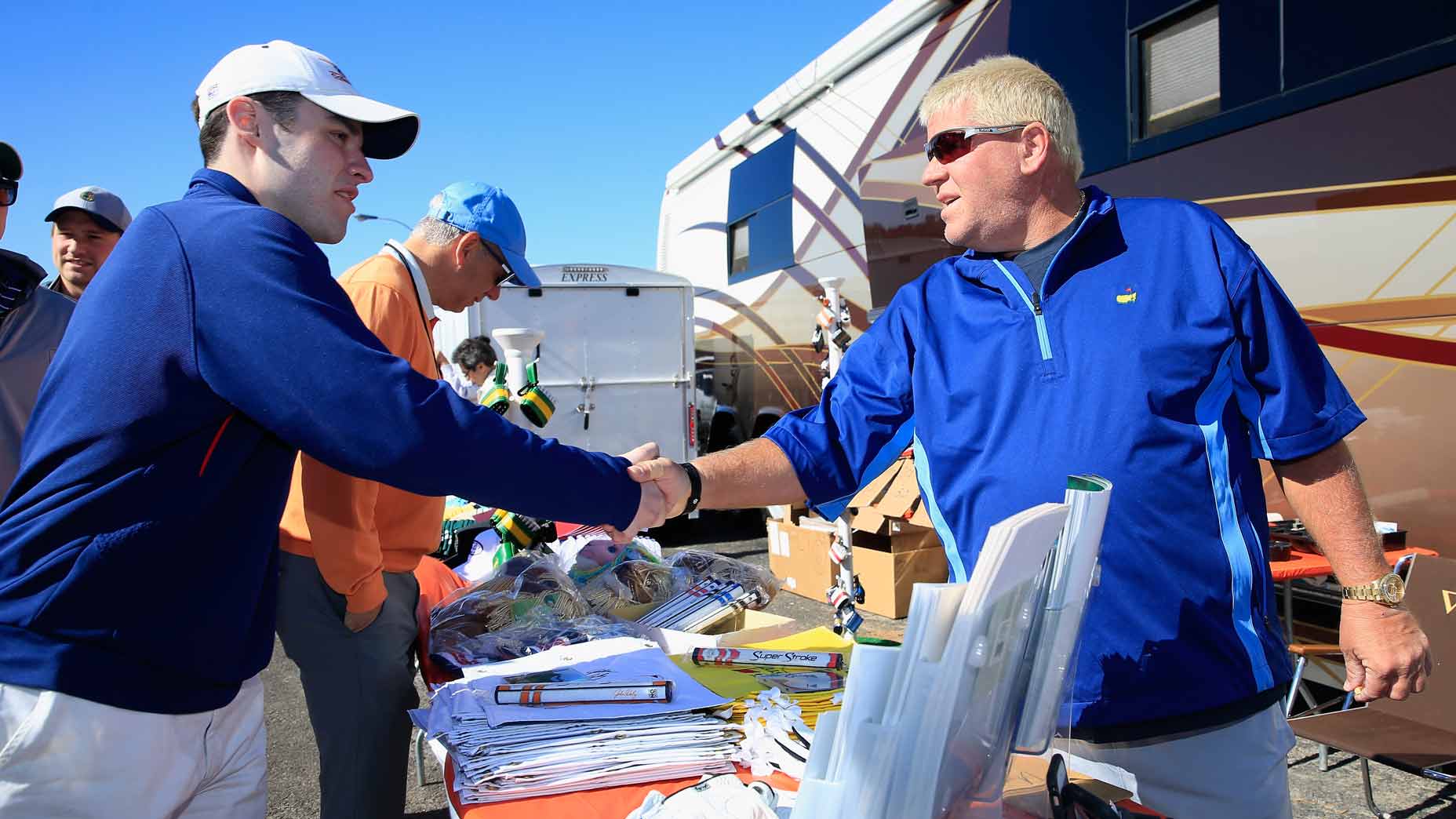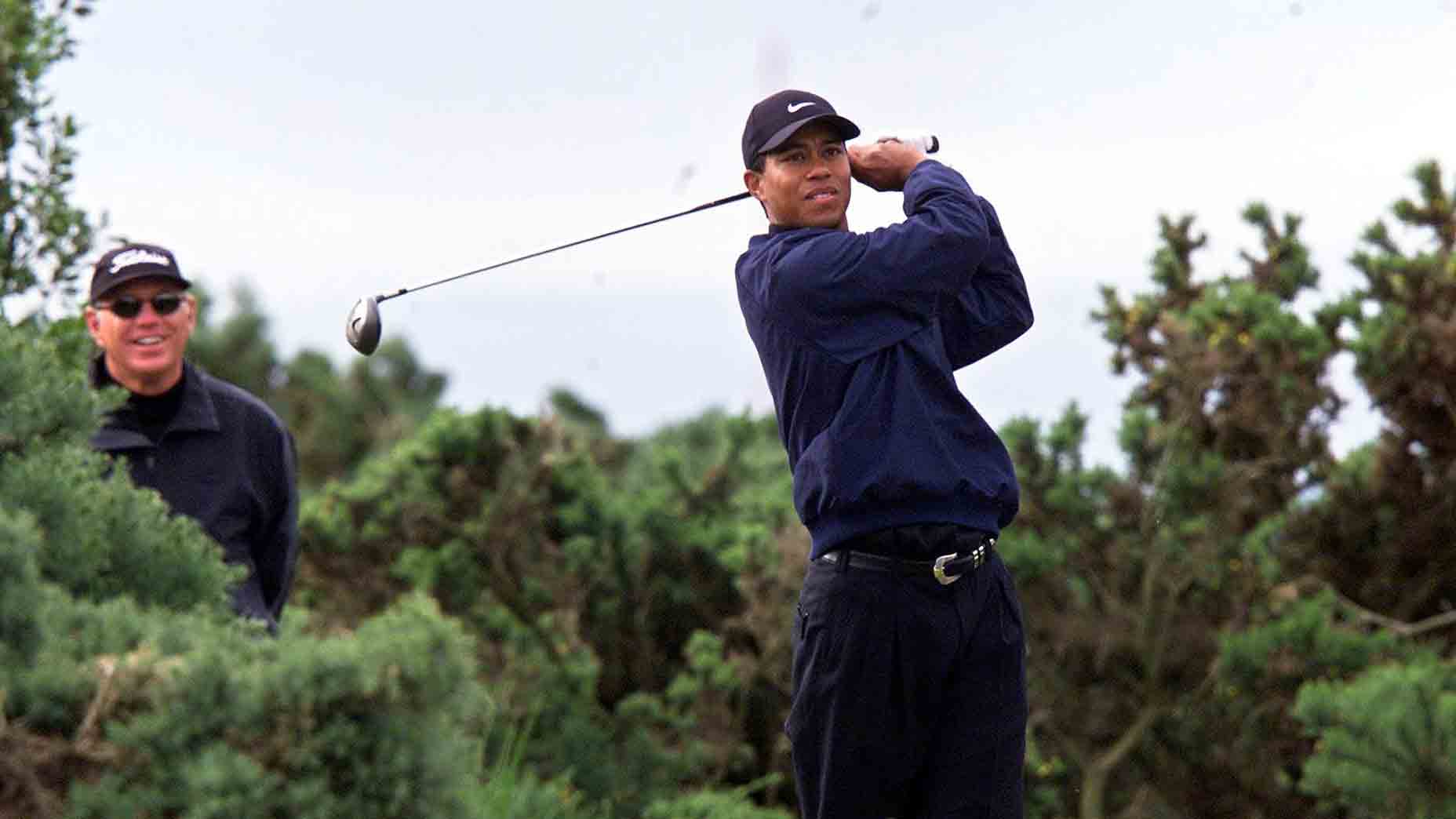CARNOUSTIE, Scotland — Note to self: never, never, never underestimate this Tiger Woods.
It’s not just his skill at playing the shots. If you’re old enough, you’ve known about that since the early 1990s. As Jack Nicklaus has said often, skill like that does not just disappear. Nicklaus would know. He won a Masters at age 46. Woods is 42.
No, it’s not the shots, and he had 66 of them Saturday, a five-under round on a rock-hard course that sent him straight up the leaderboard at this 147th British Open, leaving himself a chance — a chance — of securing his 15th major championship on Sunday. He is in a tie for sixth with six other players, and at 208 he is four shots off the lead. There are probably two dozen players in position to win. The odds are against him. But you’d be foolish to count him out.
So if it’s not the shots, the golf skill, than what is it? Four things: will, discipline, intelligence and desire.
I. Will
That is, the will Woods has shown all his life but especially since coming back from his fusion surgery, his Memorial Day arrest, his month-long stay in an addiction treatment center. Another person, with his accomplishments and wealth, might have called it a day and retreated from public life.
II. Discipline
That is, the discipline he has shown, throughout his golfing life in general and this week in particular. In the first two rounds here, Woods shot matching 71s, and scores of commentators, professional and otherwise, were practically screaming at Woods to play more aggressively. Woods listens to nobody but himself. He knows, better than anybody playing the game, when to step on the gas in a four-day tournament, particularly on a course as difficult as this one. The reason Carnoustie is the most challenging course in the Open rotation, even in the loveliness of Saturday afternoon, is that on virtually every full shot, from start to finish, the players are thinking about bunkers and burns, bunkers and burns, bunkers and burns. Find yourself in any of them and you will do well to make bogey. That’s why Woods has hit about a half dozen drivers so far this week.
III. Intelligence
That is, the intelligence it takes to clinically dissect a course, to know what your body can and cannot do in play and practice, to give meaningful answers in interviews without putting your foot in your mouth, to manage your time so that you can find satisfaction in your personal and professional life.
IV. Desire
That is, the desire to excel, to beat every other person on the course and anybody sitting comfy in the clubhouse. You have to have some hate in your heart to have as much desire as Woods has. It makes him complicated, interesting, unknowable.
Maybe you were watching on Saturday, during that roughly 15-minute period when he was playing the 16th hole. He was six under par for the day, and the tournament, and nobody was lower. Tiger Woods was leading. You almost had to catch your breath. He’s not just one of the greatest golfers ever, he’s one of the greatest athletes ever. After all he’s been through, regardless of how it has come about, it was an exciting thing, to see Tiger Woods as a man in full on Saturday.
When Woods missed about a four-footer for par on 16, a low-voiced man in the six-deep throng around the green said, “No, no, no. No, Tiger. No.” A Scotsman, you would guess. The Scots get golf, still, with the wet-wool era long dead, as no other people do. Everybody understands second chances.
How, exactly, Tiger Woods, with all that he has, is a redemption story is hard to say. But it is and he is.
There was something regal about Woods’s presence on this course Saturday, starting with an outfit Ben Hogan, who won here in 1953 at age 40, would actually recognize. Black shoes and hat, gray trousers and sweater vest, blue-and-white thin-striped shirt. The clothes of a grown-up.
Woods at address looked so solid over the ball, the way Tom Watson did, the way Nicklaus did, the way Hogan did. Woods doesn’t have a swing coach now and you can tell he doesn’t have a long checklist in his head before he swings. Yes, he takes two or three slo-mo practice swings. Yes, he sometimes literally talks to himself as he takes his stance. But once he gets settled over the ball he looks like he knows exactly what he wants to do.
The indecision you saw when he played this winter at Torrey Pines and Riviera is gone. He has always talked about taking baby steps when trying to learn a new shot or come back from a layoff. Over these past six months, Woods has taken leaps.
Which gets us back to his greatest assets, which is his will, his discipline, his intelligence, his desire. Yes, the ridiculous natural gifts he was assigned at birth were a necessary starting point to his athletic life. But Tiger Woods became Tiger Woods, the only golfer in the field on Sunday with a chance to win his fourth Open, taking advantage of gifts that all of us have, the ability to try our hardest, do our best. It’s that simple and that complicated.
It was almost comical, on Saturday, watching Woods march up 18, deeply annoyed after a horrid dead-pull two-iron tee shot finished a yard from a burn. Off to his right, another golfer, Francesco Molinari, holed out for a birdie on 16 and a giant roar went up. It was just about impossible not to look in that direction. Not for Tiger. He just grimly marched on, played a beautiful pitch shot from 85 yards and, after waiting for a yellow jacket swarming around the brim of his cap to find other airspace, rolled in a three-footer for par. There was not a bit of yip in it.
You can say of the Saturday round that when Woods was in or near the lead, he suddenly made the two worst swings of his day: the low-side miss on his short par putt on 16 and the pulled tee shot with that graphite-shafted two-iron on 18. Maybe the heat of the moment got to him. It’s possible. Woods hasn’t won a major since 2008 and he hasn’t won anything since 2013. This business is not riding a bike. He’s out of practice. He’s not the golfer he was in 2013 or 2008. He’s not the golfer he was in 2000, the year he won his first Open, at St. Andrews, by seven. Winning again will not be easy. There’s no guarantee he will. But you know he’s going to keep on trying.
He’s not the same man he was five or 10 or 20 years ago, either. Woods is a central part of the golf establishment today, and he accepts it. Mike Davis at the USGA, Fred Ridley at Augusta National, Jay Monahan at the PGA Tour and Pete Bevacqua at the PGA of America seek his opinion on this matter or that one. When he gives interviews, signs autographs, plays with players far younger than he, he knows what his responsibilities are.
You cannot say enough about the strides he has made in this broad and important category, because it is a central part of why the game is what it is. It has everything to do with the line you can draw, just to limit this discussion to American winners of the Open, from Bobby Jones to Ben Hogan to Arnold Palmer to Jack Nicklaus to Tom Watson and now to Woods. His job is to leave this game in better shape than he found it, a job he’ll have for the rest of his life. He hasn’t always seemed to understand that or accept that. But today is not yesterday.
On Saturday, Woods was paired with a 36-year-old journeyman golfer from South Africa named Shaun Norris. Norris is built like a rugby player, he uses a broomstick putter, drinks Coke on the course and has never won on a major tour. But when the round was over, Woods gave him the advice he has been giving to himself all his life: “Keep it going.” Norris took the words to heart.
Woods was happy with his round of 66 and especially happy with his par save on the last, but he also looked spent. He took a soiled towel off his bag and wiped his face down. Still, he had the grace to say to Norris, “If there’s anything I can do for you, let me know.” On that basis, Norris’s caddie retrieved four virgin golf gloves from his boss’s bag and Woods signed each of them, with good cheer. Back in the day, that was not a given.
There were 50 or so reporters crowded together to hear Woods’s comments. He used to be eager to practice after his rounds but those days are over. On Saturday he was eager to watch the rest of the telecast, to see how Jordan Spieth and Kevin Kisner and Frankie Molinari, who won Woods’s event outside Washington, D.C., earlier this month, played home. He answered questions for 10 minutes or so but his first comment was his most telling and meaningful one: “I had control of the golf ball today.” Music to any golfer’s ears.
This Saturday round was not smoke and mirrors. This was a round that showed he can win again, if he can do it for four days. That has been Tiger Woods’s stock-in-trade for the last quarter century: doing a difficult thing well not for one day or two or three, but for four. Then coming back the next time and doing it again. That’s why, like Nicklaus before him, he plays so infrequently. You can only go to the well so many times.
Anyway, it was some day and at the end of it, some score:
444 344 433 33 / 334 344 444 33
There are no 2s to be made at Carnoustie. Well there are, but not on anything like a regular basis. You can make a 5 on all 18 holes in a heartbeat. No 5s. The author of that card, that 66, is in this championship, this grandest of all majors, the one he says he has the best chance to win. Tiger doesn’t do that thing about imagining what it’s like to hoist the trophy, dream it and it will come true and all that gooey nonsense doctors with hairspray will try to sell you. He’s about the work, the swing, the application of his mind to the task at hand. If he’s dreaming about anything, it’s high winds and tough pins. The harder the course, the better for him. You remember that, right?
Michael Bamberger may be reached at mbamberger0224@aol.com.







